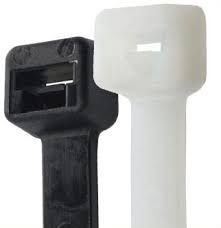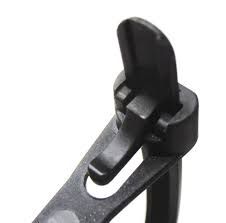Fiber optic cables are sensitive and precise. They require cable management solutions that protect their core function—high-speed, uninterrupted data transfer. The right
cable tie will secure the cables gently, without bending, crushing, or degrading signal performance. Choosing the best tie depends on application, environment, and compliance standards.
Why Fiber Optic Cables Need Special Handling
Fiber optic cables differ from traditional copper cables. Their strength lies in light transmission, not electrical current. This makes them faster and more secure—but also more fragile.
Key vulnerabilities of fiber optic cables:
- They can crack or break under pressure.
-
Tight bends can degrade signal quality.
-
Over-tightened cable ties can damage the glass fiber core.
That's why standard nylon zip ties are usually a poor choice unless designed specifically for fiber optic protection.
Essential Cable Tie Features for Fiber Optics
To protect fiber optic cables, a cable tie must offer:
1. Controlled Tension
Ties with a
low-profile locking mechanism and rounded edges prevent cutting or pinching the cable. Tension-limiting tools are often used to avoid over-tightening.
2. Smooth, Rounded Edges
Sharp edges can dig into the cable's outer jacket. Rounded or contoured tie bodies are safer for long-term use.
3. Flexible Material
Nylon 6.6 is standard, but for fiber,
softer grades or
hook-and-loop ties are preferred. In high-density applications, velcro-style straps allow rework without damage.
4. Releasable Design
Fiber cable installations are frequently adjusted. Releasable cable ties make maintenance safer and reduce the need to cut and replace ties.
5. Wider Body
A broader tie surface spreads pressure evenly. This minimizes strain and helps prevent damage from tight bundling.
Types of Cable Ties Recommended for Fiber Optics
Hook-and-Loop Cable Ties
 Hook-and-loop ties
Hook-and-loop ties (e.g., Velcro®) are the gold standard for sensitive applications. These ties:
- Offer soft and flexible bundling
- Can be reused and adjusted
- Eliminate risk of over-tightening
- Are ideal for high-performance data centers
Best for: Patch panels, racks, and sensitive indoor networks.
Low-Tension Nylon Cable Ties

Some manufacturers offer
nylon ties specially designed for fiber applications. These feature:
- Rounded heads and smooth interiors
- Lower tensile strength ratings (18–30 lbs)
- Compatibility with tension-limiting tools
Best for: Structured cabling, telecom equipment, wall-mount enclosures.
Releasable Cable Ties
 Releasable cable ties
Releasable cable ties allow removal without cutting. Ideal when fiber bundles may change during upgrades or service.
Look for:
- A release tab or trigger
- Smooth design without burrs or ridges
Best for: Flexible installations, field repairs, temporary bundling.
Tefzel® (ETFE) or Plenum-Rated Ties
 Tefzel
Tefzel is used in
air-handling spaces, these ties meet strict fire and smoke standards (UL 94V-0 or NFPA 262). Tefzel is chemically resistant and non-halogenated.
Best for: Ceiling runs, plenum spaces, mission-critical systems.
Important Standards to Consider
Fiber optic cable installations often follow strict industry standards. These help ensure that cable ties used in such systems won’t cause long-term failure.
TIA-568
This standard governs structured cabling and calls for proper bend radius, load limits, and identification methods.
BICSI Best Practices
BICSI recommends using
hook-and-loop ties or
releasable ties for fiber optic routing. They emphasize avoiding over-compression of the cable jacket.
NFPA 70 (National Electrical Code)
When running fiber in plenum areas, ties must meet
low-smoke, low-toxicity requirements.
UL 62275
Covers performance and safety for cable management systems, including flammability, strength, and material properties.
Best Practices When Using Cable Ties on Fiber Optic Cables
Even the best tie can fail if installed incorrectly. Follow these tips to prevent common issues:
1. Don’t Over-Tighten
Use a
tensioning tool with torque-limiting settings. This ensures consistency and prevents pinching or breaking cables.
2. Maintain Proper Bend Radius
Fiber optic cables have a minimum bend radius—usually 10x the outer diameter. Cable ties must not force tighter curves.
3. Use Multiple Mounting Points
Support long runs with ties every 12–18 inches to avoid sagging and movement. This protects connectors and strain reliefs.
4. Avoid Direct Contact with Edges
Route fiber away from tie heads or mounting hardware that might press into the jacket.
5. Allow Slack at Ends
Leave some slack before the tie ends or terminations to reduce mechanical stress on connectors.
Where Fiber-Safe Cable Ties Are Used
Data Centers
In high-speed fiber environments, cable ties must maintain airflow, order, and easy access.
Velcro ties dominate here due to their flexibility and gentleness.
Telecommunications
From backbone fiber to OSP (outside plant) networks, cable ties must withstand UV, heat, and potential freezing conditions.
UV-resistant, plenum-safe ties are common.
Healthcare Networks
Hospitals rely on low-latency fiber backbones. Cable ties here must meet
low smoke and
non-toxic standards for ceiling runs.
Airports and Rail Systems
Fiber links must remain secure during vibration and temperature swings. Ties must be
fire-resistant, compliant, and flexible.
Office Buildings
Cable ties keep structured wiring tidy above ceilings and behind walls.
Low-profile nylon or hook-and-loop ties are used to preserve bandwidth integrity.
Common Mistakes to Avoid
- Using rigid ties that crush fiber jackets
- Failing to use tension-control tools
- Bundling too many cables tightly in one group
- Installing near sharp metal edges without grommets or pads
- Not following bend radius guidelines
- Leaving no room for rework or expansion
A Quick Comparison of Cable Tie Options for Fiber Optics
| Type |
Best Use Case |
Key Feature |
Reusable |
Safe for Fiber? |
| Hook-and-loop |
Data centers, patch panels |
Soft, adjustable |
Yes |
✅ |
| Low-tension nylon |
Wall mounts, telecom |
Smooth, low-force |
No |
✅ |
| Releasable nylon |
Temporary setups, upgrades |
Removal tab |
Yes |
✅ |
| Plenum-rated |
Ceiling/plenum runs |
Fire-safe |
No |
✅ |
| Standard zip tie |
Electrical bundling |
Inexpensive |
No |
❌ |
Final Thoughts
Fiber optic cables need specialized cable ties that protect, not harm. Whether using Velcro, low-tension nylon, or plenum-safe materials, always prioritize flexibility, compliance, and cable integrity. The best cable tie isn’t the strongest—it’s the gentlest that still gets the job done.
For more insights and tips on cable ties and other related products, explore
cabletiesunlimited.com, get a
quick and free quote, and follow us on our social media communities on
Facebook and
Instagram!
 Hook-and-loop ties (e.g., Velcro®) are the gold standard for sensitive applications. These ties:
Hook-and-loop ties (e.g., Velcro®) are the gold standard for sensitive applications. These ties:
 Some manufacturers offer nylon ties specially designed for fiber applications. These feature:
Some manufacturers offer nylon ties specially designed for fiber applications. These feature:
 Releasable cable ties allow removal without cutting. Ideal when fiber bundles may change during upgrades or service.
Look for:
Releasable cable ties allow removal without cutting. Ideal when fiber bundles may change during upgrades or service.
Look for:
 Tefzel is used in air-handling spaces, these ties meet strict fire and smoke standards (UL 94V-0 or NFPA 262). Tefzel is chemically resistant and non-halogenated.
Best for: Ceiling runs, plenum spaces, mission-critical systems.
Tefzel is used in air-handling spaces, these ties meet strict fire and smoke standards (UL 94V-0 or NFPA 262). Tefzel is chemically resistant and non-halogenated.
Best for: Ceiling runs, plenum spaces, mission-critical systems.
